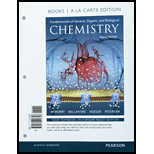
Concept explainers
Interpretation:
One example for the drug which can act as an agonist and one example for the drug which can act as an antagonist for the acetylcholine have to be listed.
Concept Introduction:
Drugs: Drugs are molecules which are taken from an external source to change the normal functioning of the body. The action of drug is in molecular level and the design of many drugs are in such a way that it mimics a particular neurotransmitter or hormone. Drugs bind with receptors showing an increased or decreased effect.
There are two types of drugs and they are agonist and antagonist.
Examples for agonist are black widow spider and nicotine whereas examples for antagonist are tubocurarine, atropine
Want to see the full answer?
Check out a sample textbook solution
Chapter 28 Solutions
Fundamentals of General, Organic, and Biological Chemistry, Books a la Carte Edition; Modified Mastering Chemistry with Pearson eText -- ValuePack ... and Biological Chemistry (4th Edition)
- List the effects of sympathoadrenal stimulation on different effector organs. In each case, indicate whether the effect is due to alpha- or beta-receptor stimulation.arrow_forwardIs atropine a competitive or a non-competitive antagonist of acetylcholine-induced responses? How did you reach this conclusion?arrow_forwardDescribe the activation of the β2 (beta2) adrenergic receptor, and briefly explain how this leads to increased breakdown of glycogen stores in muscle.arrow_forward
- Correct the following false statement: "Any cell that has the acetylcholine receptor will have the same response as any other cell that also has the acetylcholine receptor when exposed to acetylcholine". Explain why this statement is false.arrow_forwardList the Receptors for acetylcholine?arrow_forwardUnder anesthesia, acetylcholinesterase inhibitors can be given in combination with blockade of muscarinic receptors. Explain the purpose of the two treatments.arrow_forward
- Choose a medication that acts as either an agonist or antagonist. Name of medication, the receptor that binds to and what kind of reaction it causes. Give an example of a patient that would be taking this medication?arrow_forwardClassify the following neurotransmitters as excitatory or inhibitory: Acetylcholine Serotonin GABA Norepinephrine Glutamate Dopaminearrow_forwardWhat is the muscarininc acetylcholine receptor? Where is it expressed?arrow_forward
 Human Physiology: From Cells to Systems (MindTap ...BiologyISBN:9781285866932Author:Lauralee SherwoodPublisher:Cengage LearningBasic Clinical Lab Competencies for Respiratory C...NursingISBN:9781285244662Author:WhitePublisher:Cengage
Human Physiology: From Cells to Systems (MindTap ...BiologyISBN:9781285866932Author:Lauralee SherwoodPublisher:Cengage LearningBasic Clinical Lab Competencies for Respiratory C...NursingISBN:9781285244662Author:WhitePublisher:Cengage

